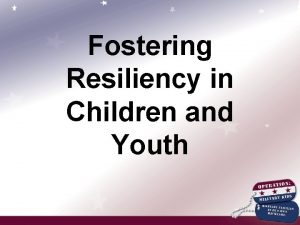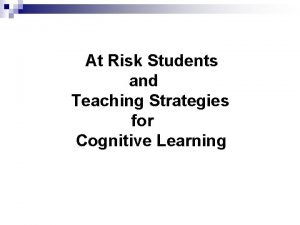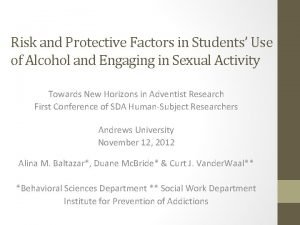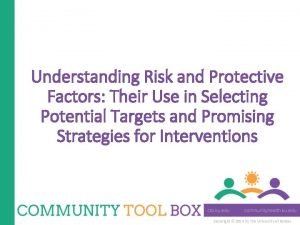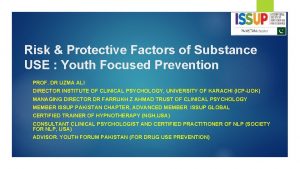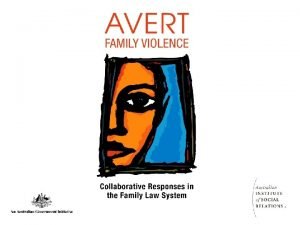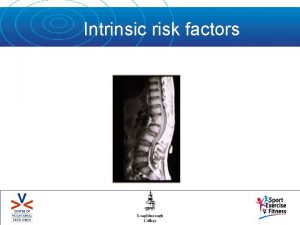Risk and Protective Factors in Students Use of















- Slides: 15

Risk and Protective Factors in Students’ Use of Alcohol and Engaging in Sexual Activity Towards New Horizons in Adventist Research First Conference of SDA Human-Subject Researchers Andrews University November 12, 2012 Alina M. Baltazar*, Duane Mc. Bride* & Curt J. Vander. Waal** *Behavioral Sciences Department ** Social Work Department Institute for Prevention of Addictions

Purpose of Presentation The basic purpose this presentation is to: 1. Consider assimilation/cultural leveling in religious subcultures. 2. Examine selective risk and protective factors related to AU student substance use and sexual activity. 3. Examine self-identified reasons for not using substances overall and by socio-demographic group. 4. Moving toward a qualitative study to examine student motives for health behavior decisions.

Cultural Leveling, Religion, Social Bonding and Health Risk Behaviors • Social Scientists have documented that over time, cultural assimilation/leveling tends to occur between social groups that occupy the same ecological space and time (Edgell & Tranby, 2010). • Parental bonding, supervision and monitoring have been found to consistently relate to lower rates of health risk behaviors (Mc. Bride et al. , 2005; van der Vorst et al. , 2006; Baltazar et al. , 2012). • Researchers consistently find that religious involvement and personal devotion/spirituality relate to lower rates of substance abuse, sexual promiscuity and other health risk behaviors (Mc. Bride, Mutch, & Chitwood, 1996; Sinha, Cnaan, & Gelles, 2007).

Macro Secular Trends Amidst the Unfolding Hegelian Dialectic • This is a study conducted at Andrews University about every 5 years since 1990 using a purposive sample of representative classes through the university; the N each time is 700 -800. • Very little change in substance use patterns over that time (Helm et al, 2009). • Sexual behavior only collected in last two rounds (2005 & 2012) – little change. • Andrews students are about 70% lower than nation on recent substance use and about 60% lower on recent sexual activity. • No evidence of cultural leveling at this point; this may represent a society move toward acceptance of value diversity (Edgell and Tranby, 2010).

Conflict and Involvement with Mother and Sexual Behavior Engaged in Vaginal Sex in the Last 12 Months Mother often irritates me 0. 146* Talk about concerns and experiences with Mother -. 163 * Can talk to Mother about alcohol, drugs, and sex -. 132* • * correlation is significant at the 0. 01 level • ** correlation is significant at the 0. 05 level

Conflict with Father and Sexual Behavior Engaged in Vaginal Sex in the Last 12 Months Father often hurts feelings 0. 146* Father often loses temper 0. 192*

Conflict and Involvement with Mother and Alcohol Used Alcohol Within the Last 12 months Mother often criticizes 0. 125* Mother often irritates 0. 121* Often argue with Mother -. 143* Prefer to talk about personal problems with Mother -. 115* Mother does a lot of things with me -. 115* Feel close to Mother -. 135* Can talk to Mother about alcohol, drugs, and sex -. 194*

Involvement with Father and Alcohol Used Alcohol Within the Last 12 months Can talk to Father about alcohol, drugs, and sex. -. 163*

Religion’s Relationship with Sex and Alcohol Use Engaged in Vaginal Sex in the Last 12 Months Used Alcohol Within the Last 12 Months Attends church services -. 243* -. 278* Attends Sabbath school -. 249* -. 272* Have personal prayer -. 204* -. 182* Have family worships -. 122* -. 202* God wants me to take care of my body -. 234* -. 376* SDA church is the true church -. 113** I will remain a SDA -. 170* -. 182*

Reasons for Not Using Substances Reasons to Not Use Substances: % Yes Commitment to Christ Concern for Health Concern for Future Children Monetary Cost Concern for Future Occupation Not Disappointing Parents Did Not Enjoy Substance Use Desire to Have Control Over Life Fear of Death Friends Do Not Use Hurts Grades Fear of Authorities 59. 7 48. 8 45. 1 38. 3 38. 1 38. 0 35. 6 35. 5 34. 5 33. 0 32. 9 29. 9

Need for Qualitative Study • Statistics of health risk behaviors by Andrews University have been fairly consistent for over 20 years. • Religiosity and parental involvement are protective factors, but how do they or other variables influence decision making? • Why do students on an Adventist campus still have premarital sex and drink alcohol even though it is a clear violation of Church/University expectations? • The studies have documented significant protective relationships, but the correlations are weak – moderate. • We need to hear from the students themselves so they can tell their story behind the 20+ years of statistics. • This will help educate parents, Adventist college campus program and policy development, and the greater SDA church in its outreach to help young people make better decisions.

Toward an Understanding of Cognitive Processes: Theoretical Framework • The main purpose of our qualitative project is to: Ø Probe the decision making process and reasons for use/engaging in or abstaining from – what rationale is used. Such issues as: 1. Micro level: a. Personal beliefs – health to spiritual/understanding of Bible b. Commitments to the future/stakes in conformity c. Fear of consequences 2. Mezzo level: a. Family bonding b. Participation in faith community c. Peer expectations 3. Macro level a. Law and policy

Methods to be Used for Qualitative Study • Andrews University students will be recruited through Behavioral Science Research Pool • 5 -7 focus groups of 8 -10 students aged 18 -25 and not married • Focus groups will be conducted early spring semester 2013 • Focus groups will be audio recorded, transcribed, then data analyzed. • Report will be completed May 2013

Questions for the Qualitative Study • Questions will be open-ended and cover the following topics: • • • Perception of College Life What led to your decision to attend Andrews University? What one word would you use to describe Andrews University? What were your expectations about being a college student? Where did these expectations come from? Have those expectations been fulfilled or not? Perception of Substance Use What are the assumptions/beliefs about alcohol/drug use among your peers? What are the reasons for using/abusing alcohol/drugs? • What are the assumptions/beliefs about alcohol use among students? What are the reasons for binge drinking (5+ drinks) or getting drunk? • What role might religious faith play in your peers’ decision to participate or not participate in these behaviors? • What role might a relationship with parents and close family members play in a person’s decision to participate or not participate in these behaviors? • • Perceptions of Sexual Behaviors • What are the personal beliefs about sexuality among people your age? What influences these views/beliefs? • What issues related to sexuality do you and your peers face during the years in college? What kind of sexual practices are acceptable or unacceptable to people your age? • What role might religious faith play in your peers’ decision to participate or not participate in these behaviors? • What role might a relationship with parents and close family members play in a person’s decision to participate or not participate in these behaviors?

References • Baltazar, A. M. , Hopkins, G. , Mc. Bride D. C. , Vander. Waal, C. J. , Pepper S. , Mackey, S. (2012, in press). Journal of Child and Adolescent Substance Abuse. • Helm, H. W. Jr. , Lien, L. M. , Mc. Bride, D. C. & Bell, B. (2009). Comparison of Alcohol and Other Drug Use Trends Between a Prohibitionist University and National Data Sets. Journal of Research on Christian Education. 18(2), 231 -245. • Mc. Bride, D. C. , Mutch, P. B. & Chitwood, D. D. (1996). Religious Belief and the Initiation and Prevention of Drug Use among Youth. In Intervening with Drug‑Involved Youth (pp. 110‑ 130). Newbury Park, California: Sage Publications. • Mc. Bride, D. C. , Freier, M. C. , Hopkins, G. , Babikian, T. , Richardson, L. , Helm, H. , Hopp-Marshak, H. , Broward, M. (2005). Sector Health Care Affairs. Quality of Parent-Child Relationship and Adolescent HIV Risk Behavior in St. Maarten. AIDS Care, 17, 45 -54. • Edgell, P. , & Tranby, E. , (2010). Shared Visions? Diversity and Cultural Membership in American Life. Social Problems, 57, 175 -204. • Sinha, J. W. , Cnaan, R. A. & Gelles, R. J. (2007). Adolescent Risk Behaviors and Religion: Findings from a National Study. Journal of Adolescence, 30, 231 -249. • Van der Vorst, H. , Engels, R. , Meeus, W. & Dekovic, M. (2006). Parental Attachment, Parental Control, and Early Development of Alcohol Use: A Longitudinal Study. Psychology of Addictive Behaviors, 20, 107116.
 Credit risk market risk operational risk
Credit risk market risk operational risk Aces protective factors
Aces protective factors Protective factors definition
Protective factors definition Jose rizal first favorite novel
Jose rizal first favorite novel Teaching at risk students
Teaching at risk students Residual risk and secondary risk pmp
Residual risk and secondary risk pmp Business vs financial risk
Business vs financial risk Relative risk and attributable risk
Relative risk and attributable risk Population attributable risk
Population attributable risk Common risk factors in the returns on stocks and bonds*
Common risk factors in the returns on stocks and bonds* Risk factors of head and neck cancer
Risk factors of head and neck cancer Are flowers biotic or abiotic
Are flowers biotic or abiotic Abiotic factors and biotic factors
Abiotic factors and biotic factors Aboitic environment
Aboitic environment Find the common factor of 12 and 24
Find the common factor of 12 and 24 Highest common factor
Highest common factor


